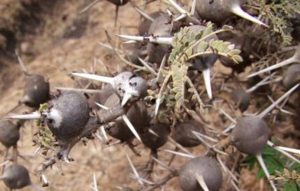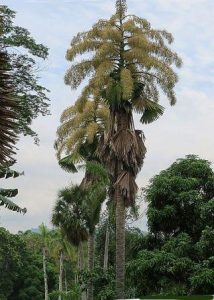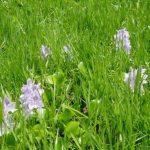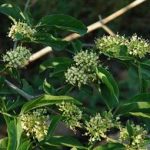TREE LIFE
February 2008
MASHONALAND CALENDAR
17th February (3rd Sunday): Return to Ngomakurira in the wet season.
We visited Ngomakurira on 17th June last year. This was a dry season visit but we had a very interesting day. We shall be exploring three different areas: (1) the wooded slope below the ridge, which contains many trees of interest; (2) the ridge itself which comprises bare granite with vegetation patches similar to Domboshawa and (3) a narrow valley filled with interesting riverine vegetation.
We expect to see a lot of interest, including the herbaceous plants in the soak zones on the rocks.
Directions. Take the Borrowdale Road out of Harare. The 27 km peg marks the city boundary, where you cross a cattle grid and enter Chinhamora Communal Land. Continue straight on following the tar road. Three km from the grid you pass the turn-off to Domboshawa, and 8.2 km from the grid you reach the Parirewa Business Centre; carry on through this, following the tar road.
Then 13.7 km from the grid, turn right onto a gravel road; 1.3 km along this road there is a sign on the left side of the road labelled ‘Ngomakurira Hill Reception’. Turn left and head straight towards the mountain. Park near the thatched building.
The cost was $12,000 per person last June but will no doubt be a lot more on the day we visit!
We will meet at 9.30 a.m. Bring chairs and lunches as usual.
23rd February (4th Saturday): By kind permission of Adrian and Odette Lind, we shall be visiting their garden in Borrowdale. We understand that they have planted a large number of indigenous trees.
Meeting time: 2.30 p.m.
MATABELELAND CALENDAR
Please contact Jean Wiley or Gill Short for details of the next Matabeleland function.
ANTS & ACACIAS – BIG MAMMALS ARE KEY TO TREE-ANT TEAM
At first it may seem counter-intuitive that preventing large African herbivores from browsing Acacia trees decreases their growth. This, however, is precisely what researchers report in Science magazine. It is all because of the Acacia’s mutually beneficial relationship with a biting ant. Together they fend off Africa’s big grazing mammals; but it is these very antagonists that are needed to keep the plant-insect team working in concert.
“Simulating large mammal extinction, by experimentally excluding them from eating the trees, causes the ant-plant mutualism to break down,” said co-author Robert Pringle, from Stanford University in California.

Acacia drepanolobium and the biting ant Crematogaster
The whistling thorn tree (Acacia drepanolobium) and the biting ant (Crematogaster) that lives on it form a relationship, evolved over many millennia, in which both species co-operate and in turn benefit from each other.
Ant bodyguards
When this ‘mutualism’ is working well, Acacia trees provide ants with swollen thorns, which serve as nesting sites, and nectar, which the ants collect from the bases of Acacia leaves. In return for this investment, ants protect the tree from browsing mammals by aggressively swarming against anything that disturbs the tree. Mr Pringle explains: “It is as if the tree hires bodyguards, in the form of ants, to protect it from being eaten.”
The researchers disrupted this relationship by fencing off six plots of savanna land in Kenya by an 8,000-volt electric fence for 10 years. Herbivores, such as giraffes and elephants, were no longer able to feed on the trees, causing a change in plant-ant dynamics.
“[The trees] diminish the rewards that they produce for the ant bodyguards, decreasing both the amount of housing and the amount of sugar-rich nectar they produce,” said lead-author, Dr Todd Palmer, at the University of Florida. He continued: “In essence, the trees begin to default on the co-operative bargain that they’ve made with the ants, because the trees no longer have need for protection from large browsing mammals like giraffes and elephants.”
It would seem that now the trees are better off, as they do not need to use their resources to support the ants – but the researchers have revealed that this is not the case. Due to lack of housing and food, the mutualistic ant species becomes less aggressive, its colony size decreases and it loses its competitive edge.
Conservation implications
“The net result is a community-wide replacement of the ‘good mutualist ant’ by a decidedly ‘bad ant’ species that does not protect the trees from herbivores, and actually helps a wood-boring beetle to create tunnels throughout the main stem and branches of the acacia trees, which the ‘bad ant’ then uses as nesting space,” Dr Palmer explains.
Trees occupied by this antagonist ‘bad ant’ grow more slowly and experience double the death rate compared with trees occupied by the ‘mutualistic ant’.
At present, the researchers do not fully understand the mechanisms that allow the tree to sense it is no longer being browsed and to turn off its investment in ‘mutualistic ants’, but they suggest it takes place over a 5-10-year period.
Dr Palmer said there were two important conservation implications of this research: “The first is that the decline of these charismatic [large animals] can have complex and cascading effects on entire ecosystems, with unanticipated results. The second is that classical conservation approaches talk about conserving species, but perhaps equally important is the conservation of ‘interactions’.”
The researchers suggest that the loss of large herbivores throughout Africa, due to ongoing human activity, may have strong and unanticipated consequences on the broader community.
Mr Pringle adds: “It is a cautionary tale.”
[Based on an interview by Anna-Marie Lever, Science and Nature Reporter, BBC News]
BULAWAYO’S HILLSIDE DAMS
The Hillside Dams, once the principal source of Bulawayo’s water supply, are in easy reach of the centre of town. Although distinct from the Matopos Hills, this area of broken kopjes and sandy open plains resembles the much larger, better-known World Heritage Site. Its natural vegetation is still largely intact and includes a wide range of indigenous species, while the bird life is diverse.
The area has attracted people since the earliest of times. There are several examples of rock paintings as well as settlements dating from the Middle Stone Age (about 200 to 40,000 years ago) to a large village contemporary with the Mapungubwe State of the Shashe-Limpopo confluence (AD 1000 – 1200). It was also the location of King Lobengula Khumalo’s favourite royal village, to which he escaped when the stresses and strains of power at the nearby capital of koBulawayo were too great. More recently it has catered for generations of Bulawayo residents seeking an accessible place of refuge and winding down.
Unfortunately, the area has been allowed to deteriorate, reflecting the severe lack of capital resources of the Bulawayo City Council. Compounding this neglect was a series of muggings and the murder of a tourist which meant that most people shunned this once-popular location. We would like to alter this situation. As a community-oriented project, the area (86 ha) has been leased by a group of local residents with the aim of restoring it. It should again be one of the prime recreational venues in Bulawayo, enjoyed by all of its residents. In addition, several educational projects are envisaged. These will focus on both natural and cultural heritages, with a commoner Ndebele village and a schools’ nature trail as key components.
We are currently initiating the renovation of existing facilities and drawing up plans for the new projects. Security and the need to fence the area, as well as beefing up the number and equipment of our security guards, are urgent priorities. However, it is no an easy thing in the current circumstances in Zimbabwe. Those interested in seeing what we are planning and wishing to keep updated on the project can visit our website: www.hillsidedams.com. Or, contact Rob Burrett on: projects@hillsidedams.com.
CENCHRUS BIFLORUS, A NEW GRASS FOR MANA POOLS NATIONAL PARK
On 30 August 2007, I noticed an unfamiliar grass close to the Zambezi River in front of the parking area near Ndungu Camp (c.357 m asl., 15°46’04″S 29°15’15″E, QDS 1529C4). The plants were on the higher end of the soak zone, where the silt and muddy sands grade into the extensive loose, unconsolidated sandbank. I didn’t make particular note of the frequency of the Cenchrus but estimate there were 30 plants in a 30 sq.m area, among other low grasses, sedges and herbs. The plants, however, preferred the drier ecozone, if you can use that term for such a small area, and thinned out as moisture and silt increased towards the river channel.
The plants were fairly short, roughly 20cm, and the inflorescence in a spike – the spikelets themselves are certainly distinctive and pierce your fingers and stick in your socks like a burr!
We only have two Cenchrus in Zimbabwe, the other being Cenchrus ciliaris or foxtail, called buffalo grass or blue buffalo grass in South Africa and elsewhere; biflorus is apparently a rare annual and thus a good find.
Mark was good enough to get the plant identified (thanks, Mark) and informed me that on our website and in Flora Zambesiaca, it is only recorded from division W (the western division) whereas Mana is in division N, the northern division. However, Mark also found that there is already a collection from Sengwa, also in division N, which we didn’t know about, so it isn’t actually new to that division. But if I am correct in guessing that Sengwa refers to the Sengwa Wildlife Research Area, that is 290 km SSW from the location where I saw them.
-Ian Riddell
THE ‘SUICIDE’ PALM HAILED AS A BOTANICAL WONDER

Tahina spectabilis (Suicide Palm, Tahina Palm). Source: Wikipedia
A 70 ft-tall plant that commits suicide when it blooms has been discovered in a remote region of Madagascar. Scientists say the spectacular giant palm introduces an entirely new family of species, making it one of the botanical wonders of the world.
The palm had remained hidden for centuries until it was found in an 800 ft-square area of swampland on the island off the southeastern coast of Africa, only accessible by air.
Dr John Dransfield, of London’s Royal Botanic Gardens at Kew, heralded the palm as a ‘mind-blowing discovery’. “Coupled with the great scientific interest of the palm is the fact that it is such an amazingly spectacular species and with such an unusual life cycle,” he said.
The palm sprouts a 70 ft-long (21 m) spire of tiny flowers once in its lifetime, dripping with nectar to beckon a host of pollinating insects. After blooming and fruiting, the plant’s nutrient resources are completely exhausted, causing it to collapse and die. Although the palm flowers fatally just once, no one knows how long it lives. Almost as remarkable is the fact that scientists have not found it until now.
Standing at up to 65 ft (20 m), with a spread of at least 30 ft (9 m), the giant palm is in fact large enough to be visible on Google Earth.
Dr Dransfield said: “Somebody sent me the reference point, and I could actually see it, which was amazing. The fact that such an enormous palm has only now been discovered is astonishing.”
There are now plans to grow it in botanic gardens around the world and sell its seeds to private collectors – although even Kew’s famous Palm House may be too small to accommodate the new discovery.
[From: https://news.sky.com/skynews/article /0,,30200-1301081,00.html]INVASIVE ALIENS
The series on invasive aliens will be continued in the March issue of the newsletter.
–Ed.



